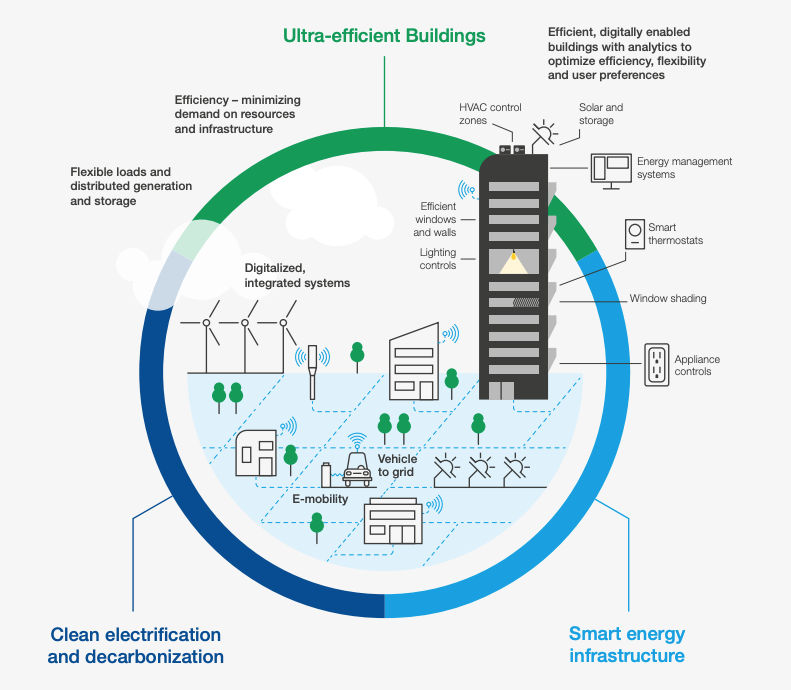Here are 3 innovations helping to create the buildings of the future

Implementing sustainable building practices can help meet climate targets by 2050.
Image: Unsplash/Chiara Guercio
Stay up to date:
Future of Construction
- Buildings contribute almost 40% of global carbon emissions, the World Green Building Council says.
- Innovations like low-emissivity glass and smart retrofitting are helping to significantly reduce carbon footprints in the built environment.
- Global collaboration, through projects like the World Economic Forum’s Centre for Urban Transformation, is key to scaling sustainable building practices and meeting climate targets by 2050.
As the world looks to accelerate efforts to combat climate change, innovative buildings and construction materials will play a critical role in meeting both climate and sustainable development goals.
According to the World Green Building Council, “buildings are currently responsible for 39% of global energy-related carbon emissions: 28% from operational emissions, from energy needed to heat, cool and power them, and the remaining 11% from materials and construction.”
The current high levels of emissions and energy use offer a huge opportunity. The World Economic Forum’s Transforming Energy Demand report, 2024, says it’s possible to reduce the energy intensity of buildings by 38%, which could help to cut global energy demand by 12%.
With the built environment responsible for nearly 40% of global carbon emissions, innovative architecture and materials science approaches are being deployed to reduce the sector’s carbon footprint. Here are three examples.
What is the Forum doing to help cities to reach a net-zero carbon future?
Sustainability by design
In Denmark, a prototype for the future of housing had a carbon footprint three times lower than the average new-build home.
The project is backed by window manufacturer Velux, which says, “each building component has been optimized for the best constellation of price, indoor climate and carbon footprint.” The company adds, “the building itself is carbon-negative through most of its lifecycle … it is designed to be taken apart easily to recycle the used building materials completely.”
Retrofitting existing buildings
All buildings represent a long-term investment with expected life spans frequently over a century. As technology and climate targets evolve, retrofitting older buildings will be required to keep them up to modern standards.
Australia’s iconic Sydney Opera House is an outstanding example of what can be achieved. Over the last decade, it has switched to 100% renewable energy use, reduced energy and water use by 20% and diverted more than 90% of construction waste from landfill. The opera house has been certified for its “world leadership in sustainability performance” by the Green Building Council of Australia.
Retrofitting buildings at scale will require innovative approaches to financing for new energy and insulation systems, the Transforming Energy Demand 2024 report says. These include:
1. Interest-free energy efficiency financing schemes, with repayments made via energy bills over a maximum of five years.
2. The development of energy-as-a-service models would eliminate upfront costs. They would also enable energy suppliers and customers to share the benefits and allow co-investment between building occupants.
3. Providing risk insurance policies to be held jointly by property owners, retrofitters and insurers would remove barriers created by parties that feel they lack agency.
4. Cooperation with city authorities, technical colleges and universities to ensure the availability of a skilled talent pool to carry out retrofitting projects.
5. Collaboration within regional industrial ecosystems to ensure a ready supply of materials and recycling services for material removed during retrofitting.
Innovative building materials
Modern materials have enabled architects and engineers to design and construct ever more ambitious buildings. Innovative materials and construction techniques are also adding to the climate credentials of buildings.
In many modern office buildings, glass covers more than 50% of the exterior. Traditional glass is a poor insulator and contributes significantly to energy loss. The latest generation of low-emissivity glass (low-e) is reducing the energy drain from glass surfaces. Triple-coated, low-e glass provides 50% better insulation than standard glass. In one project, in Türkiye, this glass helped to achieve an 81% increase in thermal insulation and 57% more effective control of sunlight.
New building techniques are also making buildings more sustainable. A team of researchers at Columbia University in New York has developed a zig-zag wall design that reduces the amount of heat absorbed by buildings.
This design uses what’s known as radiative cooling, where infrared radiation is reflected back into the atmosphere, rather being absorbed by the building and turned into heat.
Keeping buildings cooler using passive cooling could be a big win, as air conditioning systems are driving the fastest growth in energy demand, according to the International Energy Agency.
Energy efficiency will increasingly be a major focus for the buildings sector as demand grows for a sustainable built environment that limits the use of fossil fuels to heat and cool buildings.
The World Economic Forum’s Centre for Urban Transformation is bringing together the public and private sector to enable more sustainable, inclusive and resilient communities. The Centre is working with more than 240 business and civil society partners in more than 130 cities to create net zero urban environments that provide healthy, clean and nature-positive built environments for the benefit of all.
Accept our marketing cookies to access this content.
These cookies are currently disabled in your browser.
Don't miss any update on this topic
Create a free account and access your personalized content collection with our latest publications and analyses.
License and Republishing
World Economic Forum articles may be republished in accordance with the Creative Commons Attribution-NonCommercial-NoDerivatives 4.0 International Public License, and in accordance with our Terms of Use.
The views expressed in this article are those of the author alone and not the World Economic Forum.
Related topics:
Forum Stories newsletter
Bringing you weekly curated insights and analysis on the global issues that matter.
More on Urban TransformationSee all
Michael Fröbel and Stanislas Hillen
August 8, 2025
Jeff Merritt and Vivian Brady-Phillips
July 25, 2025
Muhammad Hassan Dajana and James Balzer
July 22, 2025
Olivia Nielsen
July 16, 2025
Luis Antonio Ramirez Garcia
July 14, 2025









